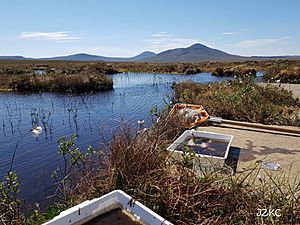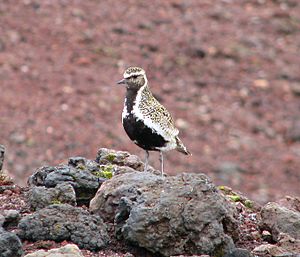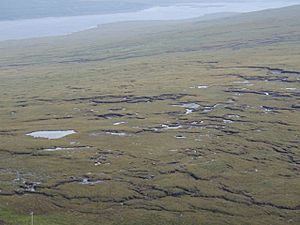Flow Country facts for kids
The Flow Country is a huge area of peatland and wetland in the very north of Scotland. It's found in places like Caithness and Sutherland. This special place is the biggest area of "blanket bog" in Europe. It covers about 4,000 square kilometers (that's about 1,500 square miles)!
A blanket bog is a type of wetland where deep peat forms. Peat is made from old, squashed plants. These plants store a lot of carbon. This means the Flow Country helps fight global warming by keeping carbon locked away for thousands of years. If the carbon was released, it would go into the air and make the Earth hotter. Because it's so unique, the Flow Country might even become a UNESCO World Heritage Site! It could also be part of the Global Peatlands Initiative.
Contents
Amazing Animals and Plants
The name "Flow Country" comes from an old language called Old Norse. "Floi" means "wet" or "marshy," which perfectly describes this area! It's a fantastic home for many different kinds of wildlife. Lots of birds come here to breed and raise their young. These include birds like the greenshank, dunlin, merlin, and the beautiful golden plover. You might also spot birds of prey, such as the buzzard and the hen harrier, soaring overhead.
One of the most important plants in the Flow Country is sphagnum moss. This amazing moss can hold a lot of water, like a giant sponge! Over time, layers of dead sphagnum moss turn into peat, which is the main building block of the blanket bog. You can also find cool carnivorous plants here. These include the roundleaved sundew, greater sundew, and butterwort. They catch and eat insects to get the nutrients they need, because the soil is very poor.
Large mammals also live here. You might see red deer roaming around all year. They make loud roaring sounds during the autumn when they are looking for mates. The less common roe deer also live in this special place.
A Look at History
Between 1979 and 1987, some big changes happened in the Flow Country. People planted lots of conifer trees and dug drains. This was done to help create jobs because many people in the area were unemployed.
However, planting trees in the bog caused problems for the natural habitat. In 1987, a group called the Nature Conservancy Council (NCC) said that planting trees was harming this special place. The government at the time decided to change things. They created a new Scottish group, now called Scottish Natural Heritage, to look after nature.
In 1988, a government official named Nigel Lawson realized that the tax rules were causing a lot of damage to this unique wilderness. So, he stopped the special tax breaks for planting trees. This helped to stop more trees from being planted in the bog. It also encouraged the Forestry Commission to think more about protecting the natural landscape.
Protecting the Flow Country
Many people and groups are working hard to fix the damage and protect the Flow Country. The Royal Society for the Protection of Birds (RSPB) has bought a large part of the area. They created the Forsinard Flows national nature reserve. Here, they are cutting down young trees that were planted and letting them rot. This helps the land slowly turn back into a peat bog, which could take 30 to 100 years!
The RSPB also led a big project called "Flows to the Future." This project aimed to restore huge parts of the Flow Country. It also helped teach people why this area is so important. As part of this project, they built the amazing Flows Lookout Tower, which has won awards.
About 1,500 square kilometers (580 square miles) of the Flow Country is protected by law. It's called the Caithness and Sutherland Peatlands. This means it's a "Special Protection Area" and a "Special Area of Conservation."
The Flow Country is also being considered to become a UNESCO World Heritage Site. This would give it a special "global badge" of importance. Experts believe it's one of the most important blanket peatland areas in the Northern Hemisphere. Protecting it helps keep this wild and ancient landscape safe for the future.
Getting There by Train
You can reach the Flow Country by train! The Far North Line connects to Forsinard station, which serves this area.






